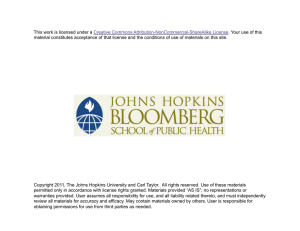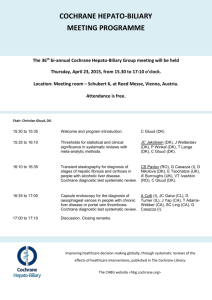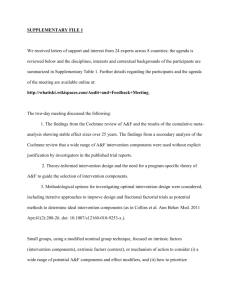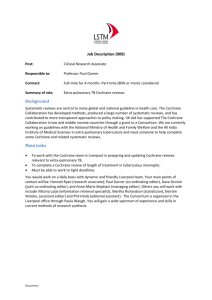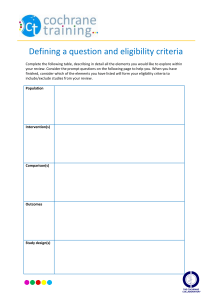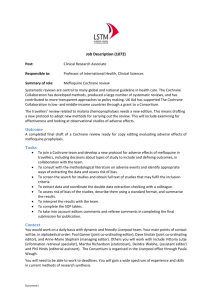Explanation of Terms - Cochrane Consumer Network
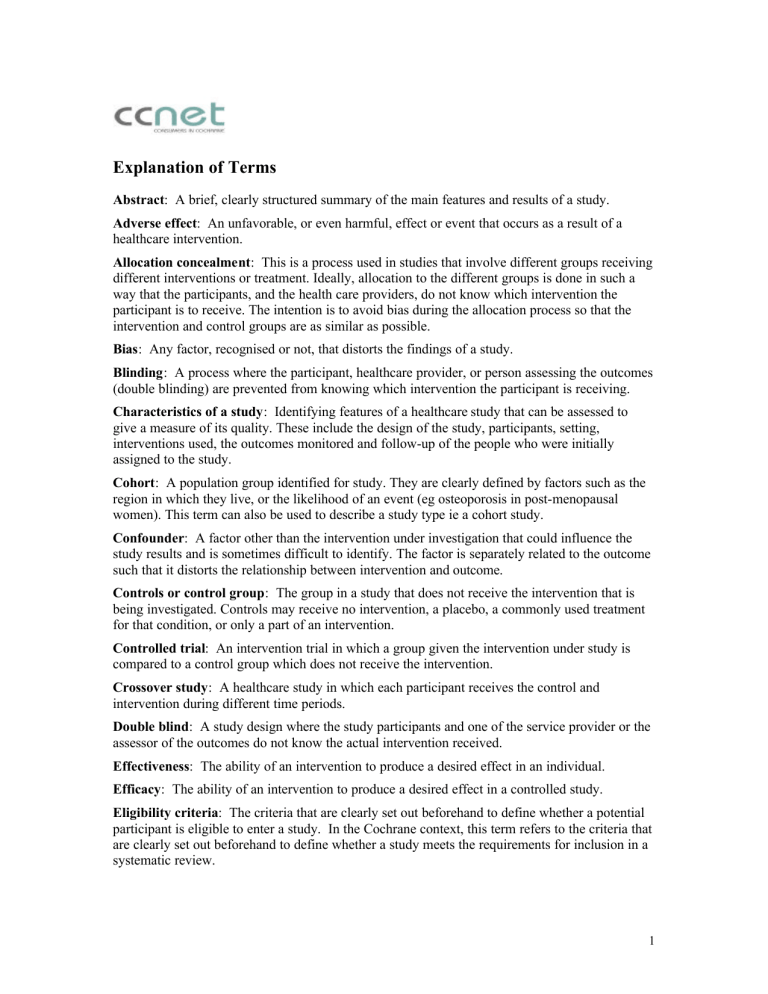
Explanation of Terms
Abstract : A brief, clearly structured summary of the main features and results of a study.
Adverse effect : An unfavorable, or even harmful, effect or event that occurs as a result of a healthcare intervention.
Allocation concealment : This is a process used in studies that involve different groups receiving different interventions or treatment. Ideally, allocation to the different groups is done in such a way that the participants, and the health care providers, do not know which intervention the participant is to receive. The intention is to avoid bias during the allocation process so that the intervention and control groups are as similar as possible.
Bias : Any factor, recognised or not, that distorts the findings of a study.
Blinding : A process where the participant, healthcare provider, or person assessing the outcomes
(double blinding) are prevented from knowing which intervention the participant is receiving.
Characteristics of a study : Identifying features of a healthcare study that can be assessed to give a measure of its quality. These include the design of the study, participants, setting, interventions used, the outcomes monitored and follow-up of the people who were initially assigned to the study.
Cohort : A population group identified for study. They are clearly defined by factors such as the region in which they live, or the likelihood of an event (eg osteoporosis in post-menopausal women). This term can also be used to describe a study type ie a cohort study.
Confounder : A factor other than the intervention under investigation that could influence the study results and is sometimes difficult to identify. The factor is separately related to the outcome such that it distorts the relationship between intervention and outcome.
Controls or control group : The group in a study that does not receive the intervention that is being investigated. Controls may receive no intervention, a placebo, a commonly used treatment for that condition, or only a part of an intervention.
Controlled trial : An intervention trial in which a group given the intervention under study is compared to a control group which does not receive the intervention.
Crossover study : A healthcare study in which each participant receives the control and intervention during different time periods.
Double blind : A study design where the study participants and one of the service provider or the assessor of the outcomes do not know the actual intervention received.
Effectiveness : The ability of an intervention to produce a desired effect in an individual.
Efficacy : The ability of an intervention to produce a desired effect in a controlled study.
Eligibility criteria : The criteria that are clearly set out beforehand to define whether a potential participant is eligible to enter a study. In the Cochrane context, this term refers to the criteria that are clearly set out beforehand to define whether a study meets the requirements for inclusion in a systematic review.
1
EMBASE : A European based electronic database (Excerpta Medica) listing health and medical publications in the medical literature.
Epidemiology : The discipline which studies the causes, distribution, and contributing factors to healthcare problems in population or community groups.
Evidence-based practice : The conscientious, explicit, and judicious use of current best evidence in making decisions about health care for and with individuals, families and communities.
Grey literature : Reports of studies that do not appear in the peer-reviewed literature. These reports are often not easily accessible and may not be in the format of papers in the general medical literature.
Intervention : A treatment, procedure or program of health care that has the potential to change the course of events of a healthcare condition.
MEDLINE : An American based electronic database listing articles of biomedical research from a pre-determined range of peer-reviewed publications. PubMed is freely accessed on the internet.
MeSH : Medical subject headings or keywords that are used to index and therefore identify articles in electronic databases.
Meta-analysis : A way of analysing information or data from a number of different studies to determine an average, or common, effect. It is aimed at improving the precision of the available data by looking at a greater number of people, including from different populations.
Morbidity : Illness or harm.
Objective(s) : The clearly stated healthcare question(s) that a study or review sets out to answer.
Outcome : A measure of the effect of an intervention that is relevant to health care.
Participant(s) : Individual(s) who take part in a study.
Peer reviewing : The process of sending articles reporting the outcomes of studies to ‘peers’ for review and comment. It is believed that the peer-review process is a useful quality control activity. In the Cochrane context ‘peer review’ refers to the process of critiquing a protocol or review. It is undertaken by fellow researchers, statisticians, health professionals or consumers.
Placebo : An intervention that to all intents and purposes appears to be the same as that which is being assessed but which does not have the active component being assessed.
Placebo effect : A change due to an expectation that the treatment or procedure will have an effect rather than the treatment or procedure itself.
Population : This term can refer to the participants involved in a healthcare study; it can also refer to a general population of people.
Protocol : In the Cochrane context a protocol is an outline of a healthcare question, its relevance, and how reviewers intend to go about answering the question. The process of developing a protocol is aimed at improving the quality of a future review and minimising bias by deciding beforehand the methods, selection criteria and outcomes to be assessed. A protocol is refereed
(peer reviewed) and published in The Cochrane Library to invite feedback as to the usefulness of the question and the process as outlined.
2
Quasi-randomised controlled trial : This term is loosely used to refer to randomised controlled trials where the method of allocation to the different groups is not sufficiently rigorous to ensure allocation concealment. These methods include alternate patients and allocating patients by birth dates.
Randomisation : A method of allocation based on chance such that individual allocation cannot be anticipated and statistical theory can be used for analysis. It is a way of ensuring groups are as similar as possible at the beginning of a study.
Randomised controlled trial : A study design in which individuals are assigned, by special randomisation techniques, to two or more groups where one group receives the intervention under investigation and the other(s) receives no treatment, a placebo, or a standard intervention.
Referee : In the Cochrane context, this refers to the person(s) to whom a protocol or review is sent for critiquing. Referees are usually fellow researchers, statisticians, health professionals or consumers of health care.
Review : In the Cochrane context, this refers to a ‘systematic review’. In the broader healthcare context it refers to any attempt to synthesise the results of more than one study on a particular topic area.
Reviewer : In the Cochrane context, this term is used to refer to the authors undertaking a systematic review. In the broader health care context this term refers to a person undertaking a review (assessment for quality relevance etc) of other people’s work.
Search strategy : In the Cochrane context, this refers to the way a search is carried out to identify publications or reports that are relevant to a review process. Bias can be minimised and the quality of the review improved by the thoroughness of the search.
Selection bias : Error due to systematic differences in characteristics between those who are selected to participate in the different arms (groups) of a study.
Selection criteria : In the Cochrane context, this refers to criteria which set out the types of healthcare studies, participants, interventions and outcomes that determine which studies are to be included in a systematic review. This helps review authors search for and identify studies and is aimed to minimise bias.
Standard treatment : The treatment, procedure or intervention that is normally or conventionally given for a condition.
Statistical analysis : The process of examining collected numerical measurements in order to determine if they are a fair representation of a situation, what value or significance can be given to them, and consequently the size and numerical significance of an intervention effect.
Study : A systematic, well-planned investigation of a healthcare problem.
Subgroup : When participants of a study are further divided according to factors other than the intervention received eg age, sex, severity of disease or physical condition, dose of intervention or quality of study.
Systematic review : A review in which all relevant studies are identified and those of adequate quality selected. Results from selected studies are usually pooled (using meta-analysis) to give the best single estimate of effect.
3
Trial : A randomised controlled trial or quasi-randomised controlled trial
Triple blind : A study design where the study participants and both the service provider and the assessor of the outcomes do not know the actual intervention received.
Title : In the Cochrane context this refers to the topic of a review. Cochrane titles have a set structure: intervention for an identified health issue (and sometimes in which population). This facilitates finding reviews using The Cochrane Library search mechanism.
Variable : A characteristic or effect that can be measured and quantified in different individuals.
See also the Cochrane Collaboration glossary at http://www.cochrane.org/resources/glossary.htm
4
Some statistical terms
Statistical analysis : The process of examining collected numerical measurements in order to determine if they are a fair representation of a situation, what value or significance can be given to them, and consequently the size and numerical significance of an intervention effect.
Absolute risk reduction (ARR) or risk difference : The difference in the rate of outcomes between the control group of a study and the intervention group. For example, if 30% of people experience a serious event in the control group and 20% in the intervention group, the ARR is
10% (30%-20%).
Binary variable : A variable which can take only one of two possible values eg before or after, yes or no, dead or alive.
Confidence intervals (CI) : A statistical measure of the precision of estimation of a population
(group) parameter at a specified probability level. These are usually 95% confidence intervals, meaning that 95% of times the value will lie within the range given, but there is a 5 in 100 chance that it will not, because of chance.
Continuous variable : A variable which can take any value within a defined range.
Dichotomous : A variable which can take one of two possible values.
Forest plot : A graphical representation, as seen on the Cochrane logo, of the result of pooling data from a number of healthcare studies. These look at an outcome from an intervention in a clearly defined healthcare situation and the vertical line in the middle is the point at which the intervention under investigation and the control have the same effect.
Heterogeneity : A wide spread of results in a collection of data that suggests extra factors other than those that have already been taken into consideration are influencing the results.
Homogeneity : A consistency of a collection of data that suggests the researcher is looking at similar situations without unknown confounders.
Intention to treat : The situation where people are entered into a healthcare study, allocated into a group, and then, for whatever reason, do not complete the study. It is important in the analysis of results to consider these people, especially if it is the intervention that led them to stop being involved by withdrawing or ‘dropping out’.
Jadad scale : A measure of the quality of a study that is being considered for inclusion in a systematic review. It takes into account randomization, blinding and intention to treat.
Mean : The average value of a variable.
Number needed to treat (NNT) : A statistical measure of the number of people who need to be given an intervention in order to observe a beneficial effect for one extra person. It is calculated from the risk difference. It is the inverse of the absolute risk difference.
Odds : A way of expressing chance that is expressed by the number of events of interest divided by the number of observations or people without this event. It can be stated as ‘one person fell for every three that did not’ (1/3=0.33) and is best used when events are rare as it then gives a similar measure as risk.
5
Odds ratio : A measure of the odds in the treatment group divided by the odds for a control group. A value of one implies no treatment effect. If the odds ratio is less than one then treatment has reduced the odds of an event (often expressed as a percent so that it gives a measure of how much in 100).
Power : The probability that a specified difference between control and intervention groups will be significant at a designated significance level, typically 5%, affected by the number of participants in a study such that larger studies have more power.
Probability : A measure of the likelihood of occurrence of an event.
P-value : A measure of the probability or likelihood that a given effect or event will take place by chance. The smaller the value the more likely that the intervention is responsible for an observed effect.
Sensitivity analysis : A determination of the reliability of a result by assessing confounders or influencing factors that may affect the outcomes measured. This may be done by repeating statistical analyses leaving out poorer quality studies or studies with relevant differences in the characteristics of the participants for example.
Relative risk ratio : A measure expressed by the risk of an event in the group receiving the intervention divided by the risk in the control group. A value of one implies no effect of treatment; less than one that the intervention reduced the risk of an event; and greater than one that the occurrence of the event is increased (often expressed as a percent so that it gives a measure of how many in 100).
Risk : A way of expressing the chance of an event taking place, expressed as the number of events divided by the total number of observations or people. It can be stated as ‘the chances of falling were one in four’ (1/4 = 25%). This measure is good no matter the incidence of events ie common or infrequent.
Risk difference : A measure obtained by subtracting the risk of an event happening in one group from that in another group. It is usually expressed as a percentage (x 100).
Standard deviation : A measure of the variability of a measurement and therefore the precision of a mean value.
Systematic error : An error that is consistently made throughout a study. It may lead to distortion of results, because of how sampling or data are handled for example.
Weighting : Giving more value to the data from one study over another when pooling data to carry out a meta-analysis. This may be because the study has a greater number of participants, is more precise in the measure for intervention effect (the value has lower standard deviations), or that more healthcare events occurred.
Weighted mean difference : An estimate of an intervention effect pooled from a number of healthcare studies, generally using continuous data that has been standardized to enable pooling.
6
References
Andejeski Y. Benefits and drawbacks of including consumer reviewers in the scientific merit review of breast cancer research. Journal of Women’s Health and Gender-Based Medicine
2002;11:119-36.
Bauman AE, Fardy HJ, Harris PG. Getting it right: why bother with patient-centred care? MJA
2003;179:253-6.
Bero L and Jadad AR. How consumers and policymakers can use systematic reviews for decision making. Annals Int Med 1997;127:37-42.
*Boote J, Telford R, Cooper C. Consumer involvement in Health research: a review and research agenda. Health Policy 2002;61:213-36.
*Cameron M. Uncovering the evidence. J Complementary Medicine Jan/Feb 2004,pp32-6,42.
Charles C, Whelan T, Gafni A. What do we mean by partnership in making decisions about treatment? BMJ 1999; 319: 780-2.
Corner J. Interface between research and practice in psycho-oncology. Acta Oncologia
1999;38:703-7.
Cuevro LG and Clarke M. Balancing benefits and harms in health care BMJ 2003;327:65-6.
Dickersin K, Braun L, Mead M, et al. Development and implementation of a science training course for breast cancer activists: Project LEAD (leadership, education and advocacy development). Health Expectations 2001;4:213-20.
Eysenbach G and Till J. Ethical issues in qualitative research on internet. BMJ 2001;323:1103-5.
Flinterman JF et al. (2001) Transdisciplinarity: the new challenge for bio-medical research.
Bulletin of Science, Technology & Society 2001;21:253-66.
Forbes B. BMJ 2003;326:1269.
Ghersi D. Making it happen: approaches to involving consumers in Cochrane reviews. Evaluation and the Health Professions 2002;25:270-83.
Gerd Gigerenzer Calculated Risks: How to know when numbers deceive you. Simon & Schuster
2002. Available through http://www.amazon.com.
Glenton C and Oxman AD. The use of evidence by health care user organizations. Health
Expectations 1998;1:14-22.
Hanley B, Truesdale A, King A et al. Involving consumers in designing, conducting and interpreting randomized controlled trials: questionnaire survey. BMJ 2001;322:519-23.
Herxheimer A. Relationships between the pharmaceutical industry and patients' organizations.
(UK) BMJ 2003;326:1208-10.
Holmes-Rovner M et al. BMJ 2001;322:664-7.
Holmes-Rovner, M., Kroll, J., Rothert, M. L.,
Schmitt, N., Rovner, D. R., Breer, L., Padonu, G., & Talarczyk, G. Patient satisfaction with health care decisions. The Satisfaction with Decision Scale. Med Decis Making.
1996;16(1):58-64.
*Joint NHMRC and CHF of Australia (2001) Statement on consumer and community participation in health and medical research. Canberra:NHMRC. http://www.nhmrc.gov.au/publications/synopses/r22syn.htm
7
Kelson MC. Consumer collaboration, patient-defined outcomes and the preparation of Cochrane
Reviews. Health Expectations 1999;2:129-35.
Lexchin J, Bero LA, Djulbegovic B, Clark O. Pharmaceutical industry sponsorship and research outcome and quality: systematic review. BMJ 2003;326:1167-76.
Macaulay AC et al. Participatory research maximises community and lay involvement. BMJ
1999;319:774-8.
Milne R and Oliver S. (1996) Evidence-based consumer health information: developing teaching in critical appraisal skills. Int J Quality in Health Care 1996;8:439-45.
Mintzes B, Barer ML, Kravitz RL et al. Influence of direct to consumer pharmaceutical advertising on patients’ requests and prescribing decisions: two site cross sectional survey. BMJ
2002;324:278-9.
Newman TB. The power of stories over statistics. BMJ 2003;327:1424-7.
Oliver S, Clarke-Jones L, Rees R et al. Involving consumers in research and development agenda setting for the NHS: developing an evidence-based approach. Health Technology Assessment
2004;8(15).
Oxman AD. Checklists for review articles. BMJ 1994;309:648-51.
Quennell P. Getting their say, or getting their way? Has participation strengthened the patient
“voice” in the National Institute for Clinical Excellence? Journal of Management in Medicine
2001;15:202-19.
Rhodes P et al. Involving patients in research: setting up a service users’ advisory group. J
Management Med 2001;15:167-71.
Sackett DL, Rosenberg WMC, Gray JAM et al. BMJ 1996;312:71-2.
Sakala C, Gyte G, Henderson S, Nielson JP, Horey H. Consumer-professional partnership to improve research: the experience of the Cochrane Collaboration’s Pregnancy and Childbirth
Group. Birth 2001;28:133-7.
Street, R. L. Jr. Active patients as powerful communicators. In W.P. Robinson & H. Giles
(Eds.), The new handbook of language and social psychology. Chichester: Wiley. 2001 p.551-
560.
Tallon D, Chard J and Dieppe P. Relation between agendas of the research community and the research consumer. Lancet 2000;355:2037-40.
Tobin M, Chen L and Leathley C. Consumer participation in mental health services: who wants it and why? Australian Health Review 2002;25:91-100.
Usdin S. Politics and Policy: Slippery slope for patient advocates. BioCentury, the Bernstein
Report on BioBusiness (USA) 24 March;A11-13.
WHO. Community involvement in health development: challenging health services. WHO
Technical Report series 809, 1991; Geneva: World Health Organization.
* key references in the preparation of this document
8
Web sites
The Cochrane Collaboration: http://www.cochrane.org
The Cochrane Library : http:// www.thecochranelibrary.com
Cochrane Consumer Network: http://www.cochrane.org/consumers/homepage.htm
Cochrane groups: http://www.cochrane.org/entities.htm#CRGLIST
Cochrane newsletters: http://www.cochrane.org/newslett/
Orientation folder for consumers: http://wwwcochrane.org/consumers/docs/
Cochrane abstracts of reviews: http://www.cochrane.org/cochrane/revabstr/index.htm
Cochrane reviews: http://www.cochrane.org/reviews/index.htm
Cochrane Library User Guide: http://www.nicsl.com.au/cochrane/index.asp
Cochrane Reviewers’ Handbook: http://www.cochrane.org/cochrane/hbook.htm
Information on the latest reviews: http://www.cochrane.org/cochrane/newreviews.htm
What’s New Digest http://www.informedhealthonline.org/item.aspx?tabId=13&pagerequest=1
Other useful links
Critical Appraisals Skills Program (CASP) http://www.phru.org.uk/~casp/casp.htm; http://www.caspinternational/org.uk/
Guidelines for consumers interested in peer-reviewing research http://eppi.ioe.ac.uk/
Applying trials and systematic reviews to individual patients http://www.nelh.nhs.uk/learning/
PubMed http://www.ncbi.nlm.nih.gov:80/entrez/query.fcgi?db=PubMed
Levels of evidence: National Health and Medical Research Council (Australia) (1999) A guide to the development, implementation and evaluation of clinical practice guidelines, Appendix B http://www.nhmrc.gov.au/publications
Consumer resources
Database of Individual Patient Experiences: http://www.dipex.org/EXEC/0/04COE
The Patient Issue: Patient experiences of health care. BMJ 2003;326:1275 on (14th June issue):
http://bmj.bmjjournals.com/content/vol326/issue7402/
Healthy Skepticism: http://www.healthyskepticism.org
Consumers’ Health Forum (Australia): http://www.chf.org.au
National Resource Centre for Consumer Participation in Health (Australia): http://www.participateinhealth.org.au
National Health Priorities in Australia: http:// www.health.gov.au/pq/about.htm
NCCHTA (UK) The Health Technology Assessment Programme: http://www.hta.nhsweb.nhs.uk/sundry/overview.rtf
Involving consumers in agenda setting for R&D for the NHS: developing an evidencebased approach (S. Oliver): http//www.ncchta.org/project.asp?PjtId=1112
National Health Service, UK, Promoting public involvement in NHS, public health and social care research: http://www.invo.org.uk/
9
SIGN (Scotland): http://www.sign.ac.uk
Center for Medical Consumers, New York: http://www.medicalconsumers.org
Informed Health Online Foundation: http://www.informedhealthonline.org
Health on the Net Foundation: http://www.hon.ch/home.html
Information and evidence for treatments: http://www.healthinsite.gov.au
http://www.besttreatments.org/ http://medlineplus.gov
*Smart Health Choices How to make informed health decisions by Judy Irwig, Les Irwig and
Melissa Sweet (Allen and Unwin 1999); http://www.health.usyd.edu.au/smarthealthchoices/
The Resourceful Patient by Muir Gray and Harry Rutter: http://www.resourcefulpatient.org
Suggested Reading
www.besttreatments.org/risk This site is produced by Unified Limited, a publishing company
.which is jointly owned by the British Medical Journal Publishing Group (BMJPG) and United
HealthCare Services Inc. It will help you, both as a consumer of medical care and a consumer peer reviewer, to have a basic understanding of risk. The "risk" section of this site explains percentages as in: "Take aspirin daily because studies show your risk of heart attack will be halved." For this statement to have any meaning, you need to know what your odds of having a heart attack without taking aspirin. Here's a more understandable way to relate the same statistics: "2% of people like you will have a heart attack in the next ten years, compared to 1% of those of you who took aspirin daily." Here's another point to keep in mind, risks, especially heart disease risks, are usually assessed in ten-year periods. However, heart drug studies usually last no more than five years.
Calculated Risks: How to know when numbers deceive you by Gerd Gigerenzer, Simon &
Schuster 2002. This book can be bought in paperback at www.amazon.com. See four different ways the same statistical benefit can be presented (page 202).
Smart Health Choices How to make informed health decisions by Judy Irwig, Les Irwig and
Melissa Sweet (Allen and Unwin 1999); http://www.health.usyd.edu.au/smarthealthchoices/
The Resourceful Patient by Muir Gray and Harry Rutter: http://www.resourcefulpatient.org
Medical dictionary and multi-language glossary
A list of medical dictionaries on the Internet is maintained by the USA's National Library of
Medicine: http://www.nlm.nih.gov/medlineplus/dictionaries.html
A glossary of medical terms in nine European languages is maintained by the European Union: http://allserv.rug.ac.be/~rvdstich/eugloss/welcome.html
10

